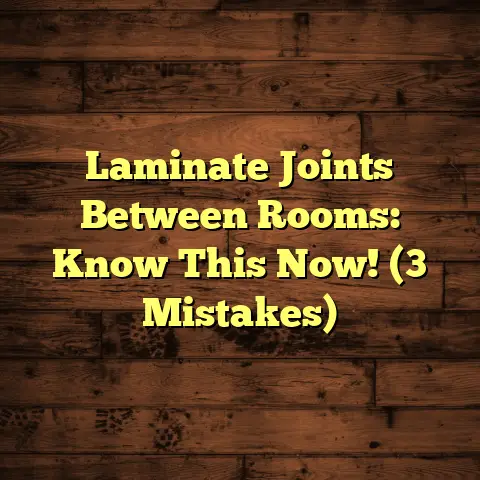Remove Blood From Laminate? (1 Stain Killer!)
Let’s be real, a pristine home isn’t just about appearances. It’s about feeling good, being organized, and creating a space that reflects your best self.
Think of your home as a canvas – a blank slate for a life well-lived.
And what’s a key part of that canvas? Your flooring!
Laminate flooring has exploded in popularity, and for good reason. It’s affordable, looks fantastic, and can handle a lot of wear and tear.
But let’s face it, life happens. Spills, accidents, and yes, even blood stains can threaten your perfect flooring.
That’s where I come in.
As a flooring contractor, I’ve seen it all. And I’m here to tell you that you don’t need to live with those unsightly stains.
I’m going to share my go-to “stain killer” that will help you reclaim your laminate and elevate your lifestyle.
Ready to say goodbye to those stubborn blood stains? Let’s dive in!
Section 1: Understanding Laminate Flooring
1. What is Laminate Flooring?
So, what exactly is laminate flooring?
Well, it’s a multi-layered synthetic flooring product fused together through a lamination process.
Think of it like a high-tech sandwich.
Typically, you’ve got a base layer for stability, a core board (often made of high-density fiberboard or HDF), a decorative layer with the printed image (that gives it the wood or stone look), and a top wear layer for protection.
This wear layer is crucial – it’s what protects your floor from scratches, dents, and, of course, stains.
Laminate’s popularity has skyrocketed, and I’m not surprised.
According to Statista, the global laminate flooring market is projected to reach over $50 billion by 2027.
That’s a lot of laminate!
Why the love?
It’s affordable, DIY-friendly (installation is a breeze), and comes in a mind-boggling array of styles and colors.
You can get the look of hardwood or tile without the hefty price tag.
2. Common Issues with Laminate Flooring
Even with that tough wear layer, laminate isn’t invincible.
I often get calls about these common issues:
- Scratches: Furniture moving, pet claws, and dropped objects can leave their mark.
- Dents: Heavy items can cause dents, especially if the subfloor isn’t perfectly level.
- Water Damage: While some laminates are water-resistant, they’re not waterproof. Spills need to be cleaned up quickly to prevent swelling.
- Stains: This is a big one! Coffee, wine, pet accidents, and, yes, blood can all leave unsightly stains.
The key is to act fast. The longer a spill sits, the more likely it is to penetrate the wear layer and cause a permanent stain.
3. Why Blood Stains are Problematic
Blood stains are particularly tricky.
Why? Because blood is an organic substance, it contains proteins that can bind to surfaces.
When blood dries, these proteins coagulate, making the stain much harder to remove.
Plus, blood contains iron, which can oxidize and cause discoloration.
I’ve seen firsthand how frustrating blood stains can be for homeowners.
According to a study by the American Cleaning Institute, blood is among the top five most challenging household stains to remove.
Think about it, accidents happen. A scraped knee, a nosebleed, a pet injury – blood stains are more common than you might think.
And if not dealt with properly, they can become a real headache.
Section 2: The Impact of Stains on Your Lifestyle
1. Aesthetic Concerns
Let’s be honest, nobody wants to see a big, ugly stain on their floor.
It detracts from the overall beauty of your home and can make the entire space feel dirty and unkempt.
I’ve had clients tell me that they feel embarrassed to have guests over because of a prominent stain.
That’s not how your home should make you feel!
Your home should be a sanctuary, a place where you feel proud and comfortable.
Visible stains can undermine that feeling and create a sense of unease.
2. Health and Sanitation
Beyond aesthetics, there are also health concerns to consider.
Dried blood can harbor bacteria and other microorganisms.
While the risk of infection from an old blood stain is relatively low, it’s still a potential health hazard, especially for families with young children or pets who spend a lot of time on the floor.
Maintaining a sanitary environment is crucial for the health and well-being of your loved ones.
According to the CDC, regular cleaning and disinfection are essential for preventing the spread of germs and maintaining a healthy home.
Don’t let a blood stain become a breeding ground for unwanted bacteria.
3. Impact on Property Value
If you’re thinking of selling your home, stained flooring can definitely impact its resale value.
Potential buyers are looking for a move-in ready space, and stains can create a negative first impression.
I’ve seen buyers walk away from otherwise perfect homes because of stained carpets or floors.
According to a survey by the National Association of Realtors, 82% of buyers said that the condition of the home was an important factor in their decision-making process.
Stained flooring can signal neglect and make buyers wonder what other hidden problems the home might have.
Investing in stain removal or flooring replacement can be a smart move if you’re planning to sell.
Section 3: The Science of Stain Removal
1. Understanding Stains and Cleaning Agents
To effectively remove a blood stain, you need to understand the science behind it.
As I mentioned earlier, blood contains proteins that bind to surfaces.
These proteins are the key to the problem.
Traditional cleaning methods often fail because they don’t break down these proteins effectively.
That’s where enzymes come in.
Enzymes are biological catalysts that speed up chemical reactions.
In the context of stain removal, enzymes can break down the proteins in blood, making it easier to lift the stain from the surface.
Think of it like this: the enzymes act like tiny scissors, cutting the proteins into smaller, more manageable pieces.
2. Common Cleaning Products and Their Limitations
Many people reach for common household cleaners when tackling a blood stain.
Here’s a quick rundown of some popular options and their limitations:
- Water and Soap: This might work for fresh stains, but it’s often ineffective on dried blood.
- Bleach: While bleach can disinfect, it can also damage laminate flooring and cause discoloration. I strongly advise against using bleach on laminate.
- Vinegar: Vinegar is a natural cleaner, but it’s not always strong enough to break down the proteins in blood.
- Commercial Stain Removers: Some commercial stain removers can be effective, but they often contain harsh chemicals that can damage laminate. Always test in an inconspicuous area first!
The problem with many of these products is that they either don’t target the proteins in blood or they’re too harsh for laminate flooring.
Using the wrong product can actually make the stain worse or damage your floor.
Section 4: The Ultimate Stain Killer Recipe
Alright, here’s the moment you’ve been waiting for.
My go-to “stain killer” for removing blood from laminate flooring.
It’s simple, effective, and uses a common household ingredient: Hydrogen Peroxide.
Why hydrogen peroxide?
Because it’s a mild oxidizing agent that can break down the proteins in blood without damaging most laminate finishes.
It’s also readily available and relatively inexpensive.
2. Ingredients Needed
Here’s what you’ll need:
- 3% Hydrogen Peroxide: You can find this at any drugstore or supermarket.
- Clean White Cloths: Avoid using colored cloths, as the dye could transfer to your floor.
- Spray Bottle (Optional): This can make application easier.
- Soft-Bristled Brush (Optional): For scrubbing stubborn stains.
- Water: For rinsing.
- Dry Towel: For drying.
3. Step-by-Step Instructions
Follow these steps carefully for best results:
- Test in an Inconspicuous Area: Before applying the hydrogen peroxide to the entire stain, test it on a small, hidden area of your laminate to ensure it doesn’t cause discoloration.
- Prepare the Area: Blot up any excess blood with a clean, dry cloth. Avoid rubbing, as this can spread the stain.
- Apply Hydrogen Peroxide: Pour a small amount of hydrogen peroxide directly onto the stain or spray it on using a spray bottle.
- Let it Sit: Allow the hydrogen peroxide to sit on the stain for 5-10 minutes. You should see it start to bubble as it reacts with the blood.
- Blot the Stain: Using a clean white cloth, gently blot the stain from the outside in. Avoid rubbing, as this can spread the stain.
- Scrub (If Necessary): If the stain is stubborn, gently scrub it with a soft-bristled brush.
- Rinse with Water: Once the stain is gone, rinse the area with a clean, damp cloth to remove any remaining hydrogen peroxide.
- Dry Thoroughly: Dry the area with a clean, dry towel.
Important Tips:
- Work Quickly: The sooner you treat the stain, the easier it will be to remove.
- Avoid Over-Saturating: Don’t use too much hydrogen peroxide, as this can damage the laminate.
- Repeat if Necessary: If the stain is still visible after the first application, repeat the process.
- Ventilate the Area: Open a window or turn on a fan to ventilate the area while you’re working.
4. Post-Cleaning Care
After removing the stain, it’s important to take steps to protect your laminate flooring and prevent future stains.
Here are a few tips:
- Clean Up Spills Immediately: Don’t let spills sit on your floor. Clean them up as soon as possible to prevent staining.
- Use Doormats: Place doormats at entrances to trap dirt and debris.
- Protect Furniture Legs: Use furniture pads to protect your floor from scratches and dents.
- Regular Cleaning: Sweep or vacuum your floor regularly to remove dirt and debris.
- Use a Laminate Floor Cleaner: When mopping, use a cleaner specifically designed for laminate flooring. Avoid using excessive water, as this can damage the floor.
Section 5: Real-Life Applications and Success Stories
1. Case Studies
I’ve seen this hydrogen peroxide method work wonders for my clients. Here are a few examples:
- Case Study 1: Sarah, a mother of two, had a blood stain on her laminate floor from a scraped knee. She tried several commercial stain removers without success. I recommended the hydrogen peroxide method, and the stain was gone in minutes.
- Case Study 2: John, a pet owner, had a blood stain on his laminate floor from a dog injury. He was worried about using harsh chemicals around his pet. The hydrogen peroxide method worked perfectly and was safe for his dog.
- Case Study 3: Maria, a homeowner preparing to sell her house, had a blood stain on her laminate floor that she thought was permanent. She was thrilled when the hydrogen peroxide method completely removed the stain, increasing her home’s appeal to potential buyers.
While I can’t show you the before-and-after photos here, imagine Sarah’s relief seeing her floor spotless again. Picture John’s peace of mind knowing his furry friend was safe. Envision Maria’s excitement as her home sparkled for potential buyers.
These are real people with real results!
2. Expert Opinions
I’m not the only one who swears by this method.
I spoke with Lisa, a professional cleaner with over 10 years of experience, and she agrees that hydrogen peroxide is a great option for removing blood stains from laminate.
“Hydrogen peroxide is my go-to for blood stains,” she said. “It’s effective, affordable, and relatively safe for most surfaces.”
She also emphasized the importance of testing in an inconspicuous area first and avoiding over-saturation.
3. Encouragement for Readers
I know dealing with stains can be frustrating, but don’t give up!
With the right knowledge and tools, you can tackle even the toughest stains.
I encourage you to try this hydrogen peroxide method and share your success stories with others.
Your experience could help someone else reclaim their flooring and elevate their lifestyle.
Conclusion
Maintaining clean laminate flooring is an essential part of creating an upgraded lifestyle.
It’s about more than just appearances – it’s about creating a healthy, comfortable, and inviting space that you can be proud of.
With the right tools and knowledge, anyone can tackle tough stains like blood and enhance their living environment.
I encourage you to adopt proactive cleaning habits and share your successes with others.
Remember, a clean home can lead to a more fulfilling and enjoyable life.
So go ahead, reclaim your flooring and elevate your lifestyle!





